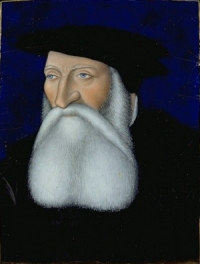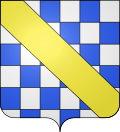Assier
Assier (French pronunciation: [asje]; Occitan: Assièr) is a commune in the Lot department in the Occitanie region of south-western France.
[3] The Brive-la-Gaillarde to Rodez railway passes through the commune from north-west to south-east with Assier station just west of the village.
A small stream flows with a slight slope parallel to the D653 in a wide valley flooded during heavy rain.
[4] Assier is located at the end of an Early Jurassic formation called Limargue at the edge of the Causses limestone.
The oldest Early Jurassic terrain is in the Ruisseau d'Assier to the north-west: The valley floor consists of alluvium brought down by modern streams.
The limit of the Drainage basin is located to the north of Assier, water flows towards the south towards the Célé:[5] this is the system called "Gramat-Sud" which drains 330 square kilometres.
[6] To the north-west, north of Vialans, there are the emergences of Routabous and Tour de Maroc of calcareous sandstone from the Pliensbachian period.
Four other dolmens and a menhir were also present north-west of the village in the hamlet of Mons at a place called Le champ de Belair.
Assier had the Abbot of Figeac as their Lord and it was attached to the Order of St. John of Jerusalem though some hamlets such as Vialan depended on the Hospital of Issendolus.
It included: a fortified house, a church dedicated to St. Peter, a hospital on the site of the Chateau of Galiot de Genouillace, a leprosarium at a place called Malaudie on the road to Reyrevignes.
[19] List of Knights and Priests of the Order of St. John of Jerusalem who were tax collectors in Assier:[19] From 1355, the entire Quercy region became a theatre of struggle during the Hundred Years War.
After the French defeat at the Battle of Poitiers, the Treaty of Brétigny gave England the Guyenne and Gascony.
[9] Assier and its surroundings were ruined, it had to repopulate the country by bringing families from Auvergne, Rouergue, and elsewhere by providing favourable conditions.
Widowed in 1543, she remarried the Palatine Prince Philip de Saim called Rhinegrave and converted to the Protestant religion.
Their son, Jean de Beaudiné, was invited to the wedding of the future Henry IV and was killed in 1572 during the St. Bartholomew's Day massacre.
[9] On 14 September 1788 Jean-Pierre Séguy, notary, bought the land of the Devèze d'Assier and became a co-lord of Assier.
Jean-Pierre Séguy redistributed land he had bought to all the inhabitants of Assier present and future (from pregnant women) who each received 0.34 hectares.
[9] During the mandates of Antoine Pezet and Joseph Carbonel from 1848 to 1870 many decisions were taken to improve the lot of the poorest:[9] In 1854 two rail projects passing through Assier were considered then abandoned.
A Classification yard was to have been located in the commune and there were plans to build a hotel-restaurant with 16 rooms near the proposed route of the line.
[9] In 1905 and 1910 tramway projects were considered to serve Assier station and neighbouring communes: a line from Gourdon to Le Bourg via Quissac and Espédaillac.
On 30 October the mayors of Cardaillac, Fourmagnac, Fons, Reyrevignes, and Assier met and decided that the electric current should be supplied by the hydro-electric plant of Mr. Barrière located on the Drauzou but in 1927 the council denounced the agreement with Mr. Barrière on the grounds that his plant could not supply power permanently because the flow of the Drauzou was too irregular.
Many shops and services are available on the town: butchers, bakers, a Pâtisserie, a bar, hairdressers, restaurants, a florist, and a grocery store; as well as tradesmen: roofers, carpenters, electricians, plumbers, heating, and a taxi.
Begun in 1540 and completed in 1549 the church is in monumental style and solely dedicated to the glory of Galiot de Genouillace with his reclining statue and the epitaph "After death, good name remains".
Jean Bergue remarked in his 1987 study that this artistic and historical masterpiece has visibly deteriorated over a hundred years.
[36] The sculptural elements represent the triumph of the artillery with the cannon the most widespread theme namely: the Culverin bastard, palace sieges, round shot with three flames, ancillary parts of a very high precision that make this frieze a true archival document on the art of war at the time with no equivalent.
There are swords with a Fleur-de-lis Baldric recalling the charge by the Grand Squire of France next to the collar of the Order of St. Michael which was the highest distinction of the time.
It contains the tomb of Galiot de Genouillace who is represented on the marble reclining statue in court dress and then in armour leaning on a cannon and surrounded by bullets and bags of gunpowder.
The vault of this chapel is quite remarkable and unique in France: there is only one other example of this architecture in Europe - the monastery of San Domingo at Valencia in Spain.
Both have a vault and a dome with triple ribs and Lunettes which give the impression of a star with a complicated design or a huge spiderweb canvas in which it is thought the final cut to size of some stones was performed after laying.
The Church of Saint Pierre contains three items which are registered as historical objects: The Assier school enrols children from eleven neighbouring communes.










